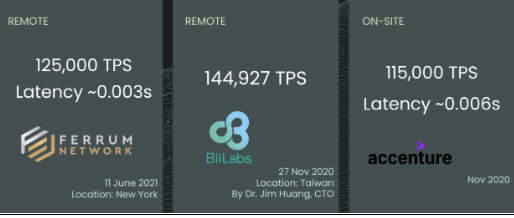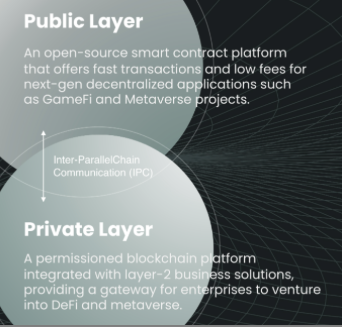- The ParallelChain platform offers low fees and fast transactions, creating the perfect ecosystem for decentralized applications.
Blockchain has come an incredibly long way since its conception in 2008. However, while significant strides have been made, a selection of central barriers still prevents this technology from excelling to the extent that it potentially could. The primary limitations of blockchain technology revolve around its scalability, the lack of interoperability between chains, and the limitations on speed.
While these limitations were once assumed to be a natural part of the blockchain, one ecosystem is actively building to overcome them. ParallelChain, founded in 2018, seeks to revolutionize blockchain by overcoming the bottlenecks that were once considered inherent in its design.
As ParallelChain offers innovative solutions that allow for the merging and interconnectivity of public and private chains and the ability to scale without limitation, many can’t help but wonder – is this the next step in blockchain’s development?
Introduction to ParallelChain
Based on a delegated proof of stake consensus mechanism, ParallelChain acts as a new layer one protocol. While other layer one platforms offer either public or private networks, ParallelChain offers both public and private networks, with interoperability protocols allowing for inter-ParallelChain Communication.
The flexibility of offering both private and public networks allows ParallelChain to act as the DeFi solution to any business, large organization, or individual looking to create a decentralized application.
This new blockchain infrastructure is said to delive faster completion times and greater throughput than its competitors, creating a revolutionary new step in blockchain technology. In addition, the infrastructure allows for a tighter focus on both privacy and accountability, allowing for scaling into new blockchain solutions without compromising on factors like being censorship-free.
What Sets ParallelChain Apart From Other Layer 1 Blockchain Ecosystems?
While leading layer one ecosystems like Avalanche and Solana boast speed and efficiency, they achieve these feats by sacrificing a level of security. Both of these services are weak to DDoS attacks, with their centralized design making them vulnerable to cyberattacks. On the other hand, ParallelChain offers both privacy protection and high-speed integrations, performing both central characteristics without compromising on the other.
This isn’t all that sets this platform apart from its competitors. Several aspects define ParallelChain as a distinguished figure in the decentralized world:
- Data Privacy Protection
- Proof of Immutability
- Biometric Recognition
Let’s break these down further.
Data Privacy Protection
ParallelChain is currently the only blockchain that has data privacy protection and GDPR compliance. While it was assumed for long that blockchain and consumer privacy would be two immiscible industries, ParallelChain has formulated a method to get around this.
Recently submitted to patent confirmation, ParallelChain will be the first layer one blockchain ecosystem that provides complete data privacy protection once approved and launched.
Proof of Immutability
Another aspect of ParallelChain that’s currently pending patent confirmation is that proof of immutability enables parties using ParallelChain to ensure that the network is tamper-free. Without accessing on-chain data, this tool will provide a tamper-proof network.
For businesses that are reluctant about sharing their data with others, this allows them to do so without worry. In addition, ParallelChain again represents the first company to use this system, further revolutionizing what layer one can do.
Biometric Registration
As an additional element of the ParallelWallet application, ParallelChain has embedded an extensive biometric recognition system. This technology is an innovation, demonstrating that the tech utilized by ParallelChain’s systems goes beyond anything currently on the market.
ParallelChain stands above its competitors for the incredible range of technological advancement demonstrated, whether within the system itself or the ecosystem that acts as a support. Additionally, with further focus on security without the need to lose speed, this platform dominates alternatives like Solana.
Key Features
This ecosystem is primarily built up of two layers: the public and private layers. Yet, this is far from all there is to ParallelChain, with their innovative approach to blockchain creating new development systems. We’ll be discussing the functionality of these two chains and touching on the interoperability link between them.
Let’s see how these key features come into play.
ParallelChain Private
ParallelChain Private was the first aspect of this layer one system released, launching in 2018. Focusing on allowing users to build privately-owned applications on a high-performance blockchain platform, ParallelChain Private accommodates enterprise solutions.
Due to the incredible 120,000 TPS speed of ParallelChain and the low 0.003 average latency, the private platform was perfect for a whole range of enterprise client solutions. In addition, it was used To accommodate everything from supply chain tracking to company data security monitoring, the potential to add AI integrations further bringing a rich toolset to the platform.
What makes ParallelChain Private so unique is the limitless ability to scale, with the platform not receiving any speed impact due to the number of transitions occurring. Additionally, with the platform’s emphasis on data protection, both consumer privacy compliance and business-sensitive data are protected.
ParallelChain Private’s final feature that allowed for further interconnectivity was the ability to migrate hyperledger-powered applications onto the system with ease.

ParallelChain Mainnet
Two years after the launch of ParallelChain Private, the blockchain system was ready to announce its next chain, ParallelChain Mainnet. This is a blockchain platform specially made for decentralized applications which are completely open-source. With unique proof-of-stake consensus integration into the core of the ecosystem, ParallelChain Mainnet offers both high performance and a playground for decentralization.
This smart contract platform offers low fees and fast transactions, creating the perfect ecosystem for decentralized applications.
Currently, the ParallelChain Mainnet is being used for four central aspects:
- NFTs – A comprehensive NFT platform that handles everything from trading to minting, ParallelChain Mainnet offers an incredibly low fee.
- Games – Removing the problem of lag once and for all, this high-performance system is the perfect solution to gaming, processing complex logic within milliseconds.
- DEXs – No matter whether order book or AMM, ParallelChain Mainnet’s smart contract deployments can support a huge range of DEX protocols
- Platform for development – Any DeFi application will have a home on ParallelChain Mainnet, with the fastest layer 1 system providing the perfect structure to build with.
Inter-ParallelChain Communication
Still, the Inter-ParallelChain Communication (IPC) allows the two ParallelChain platforms to become interoperable in development. An application created on one platform will then work on the other. Alongside functionality, connecting the chains also leads to sharing particular features.
The ParallelChain Private will be able to use ParallelChain Mainnet’s proof-of-stake mechanism to decentralize itself further, experiencing even stronger security without giving up any of its own core features.

This connection mechanism will also bridge the gap between traditional systems and decentralized ones. Furthermore, this will lead to innovative new forms of connection, with information needing consumer data protection being stored on the ParallelChain Private. In contrast, the benefits of that information can be accessed on ParallelChain Mainnet.
The linking of these platforms will formulate a new step in blockchain technologies, creating interoperability that has not yet been seen in the blockchain.
ParallelWallet
The ParallelChain Wallet system will act as a transferring system between people and businesses. By connecting directly into the ParallelChain Private and ParallelChain Mainnet systems, ParallelWallet will allow for seamless and instantaneous transferability.
Additionally, by incorporating innovative biometric systems, ParallelChain will eliminate the need for passwords or private keys. They are currently the only layer one ecosystem that offers triple biometric recognition on a crypto wallet. With detection for face, voice, and palm, this comprehensive biosecurity system brings additional security to the platform.
With this, they effectively combat one of the most significant weak points in blockchain and a problem that has led to wallets being emptied by those with their private keys leaked. In addition, this will similarly stop key-store phishing as security keys have now become obsolete in the face of advanced biometrics.
Final Thoughts
Providing an ultra-fast, low-fee, and innovative layer one solution, ParallelChain seems to represent the next step in blockchain technologies. Furthermore, with interoperability connecting both public and private layers of this system, the interaction between the metaverse and real word is realized.
While still partially in development, ParallelChain is undoubtedly a business to watch out for over the coming years.


